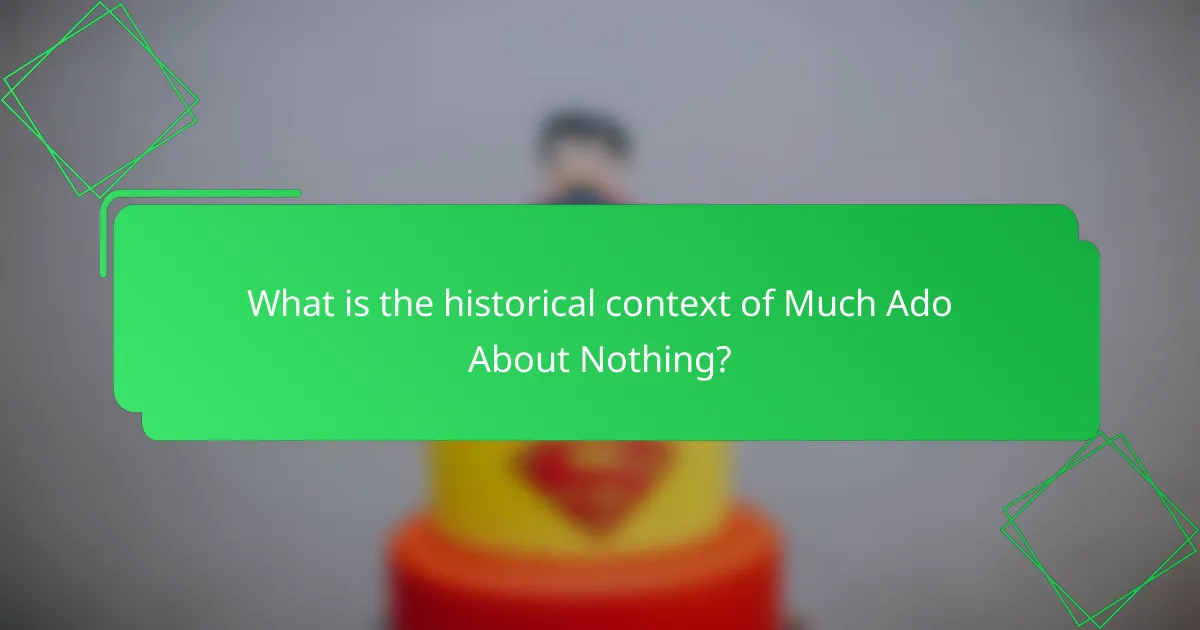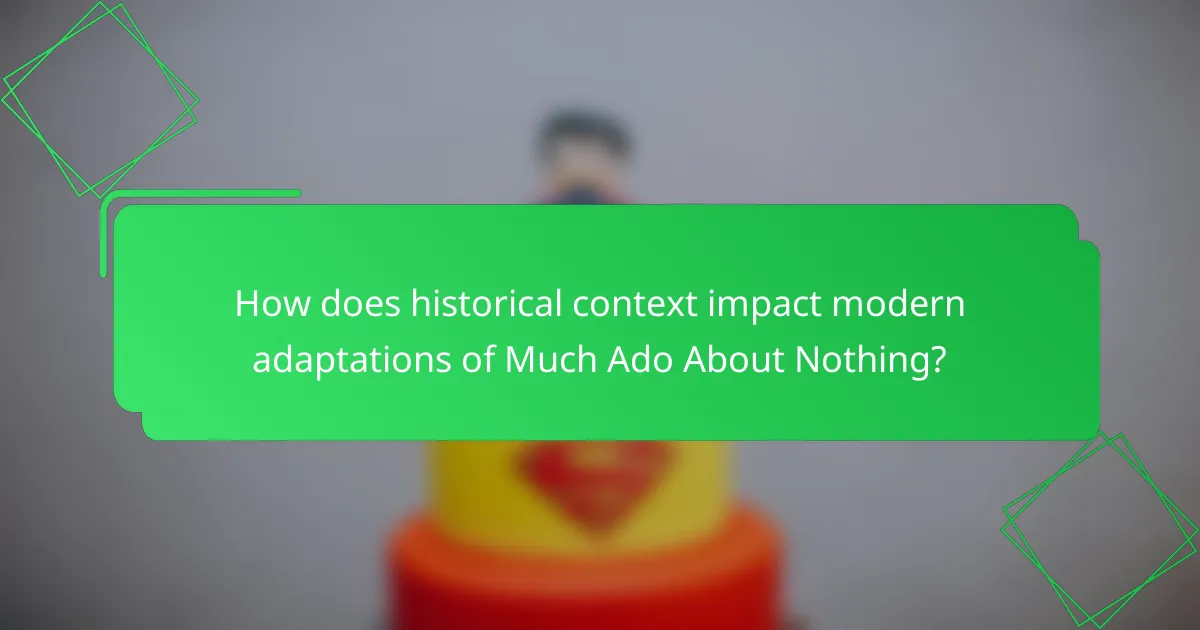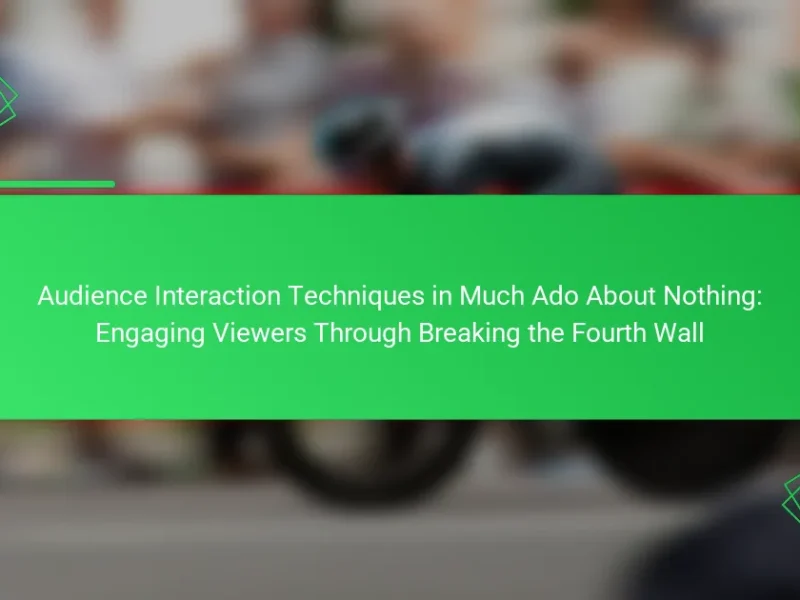
What is the historical context of Much Ado About Nothing?
Much Ado About Nothing was written in the late 16th century, during the English Renaissance. This period was characterized by a flourishing of literature, arts, and culture. The play reflects the social norms and values of Elizabethan society. Gender roles were strictly defined, with men holding power and women expected to be submissive. Courtship and marriage were significant themes, often influenced by family honor and social status. The play’s comedic elements address misunderstandings and deceptions, mirroring the complexities of relationships in that era. Shakespeare’s audience would have been familiar with the customs and expectations surrounding love and fidelity. The historical context informs the characters’ motivations and the play’s resolution. Much Ado About Nothing remains relevant due to its exploration of timeless themes within a specific cultural framework.
How did the societal norms of Shakespeare’s time influence the play?
The societal norms of Shakespeare’s time significantly influenced the play. Gender roles were strictly defined, affecting character interactions and plot development. Women were expected to be submissive and virtuous. This is evident in the character of Hero, who embodies these ideals. Marriage was a social contract, often prioritized over love. This is reflected in the arranged marriage between Hero and Claudio. Social class distinctions also played a crucial role. Characters like Dogberry, a lower-class figure, provide comic relief while highlighting class dynamics. The norms of honor and reputation shaped the characters’ actions and decisions. For instance, Claudio’s public shaming of Hero demonstrates the importance of honor in society. Overall, these societal norms create a framework that influences character behavior and plot progression in the play.
What specific historical events shaped the themes in Much Ado About Nothing?
The themes in Much Ado About Nothing were shaped by the historical context of the Elizabethan era. This period was marked by the rise of the Renaissance and a renewed interest in classical literature and humanism. Social hierarchies and gender roles were prominent, influencing the play’s exploration of love, honor, and deception. The political climate, including the tensions between England and Spain, also impacted the themes of loyalty and betrayal. Additionally, the influence of courtly love traditions is evident, reflecting societal expectations of romance and marriage during that time. These historical factors collectively inform the play’s narrative and character dynamics.
How did gender roles during the Elizabethan era affect character dynamics?
Gender roles during the Elizabethan era significantly influenced character dynamics in literature and theater. Men were typically portrayed as dominant figures, embodying authority and control. Women, conversely, were often depicted as submissive, emphasizing traditional domestic roles. This dynamic created tension in character interactions, particularly in works like Much Ado About Nothing. For example, the male characters often exerted power over female characters, shaping their decisions and actions. The expectations of femininity limited women’s agency, affecting their relationships and conflicts. These gender roles also dictated the portrayal of love and courtship, often reflecting societal norms. The representation of gender ultimately shaped audience perceptions and character motivations.
What are the key performance techniques used in Much Ado About Nothing?
Key performance techniques in Much Ado About Nothing include physical comedy, witty dialogue, and character-driven interactions. Physical comedy enhances the humor and engages the audience. Witty dialogue showcases Shakespeare’s wordplay and clever banter. Character-driven interactions reveal deeper relationships and motivations. These techniques adapt the play for modern audiences, making it relatable and entertaining. Productions often emphasize these elements to resonate with contemporary viewers.
How have performance techniques evolved from Shakespeare’s time to today?
Performance techniques have evolved significantly from Shakespeare’s time to today. In the 16th and 17th centuries, performances were characterized by minimal staging and reliance on the audience’s imagination. Actors used exaggerated gestures and vocal projection to convey emotions and actions. Modern performances incorporate advanced technology, including lighting and sound design, enhancing the audience’s experience.
The use of naturalistic acting styles has become prevalent, moving away from the stylized performances of the past. Contemporary theater often emphasizes character development and psychological realism. Additionally, diverse interpretations and adaptations of Shakespeare’s works now cater to various cultural contexts and audience demographics.
The rise of digital media has also transformed how performances are disseminated, with live-streaming and recorded productions reaching global audiences. This evolution reflects changes in societal norms and expectations surrounding theater. Overall, performance techniques have adapted to enhance engagement and accessibility for modern audiences.
What role does language play in the performance of Much Ado About Nothing?
Language in “Much Ado About Nothing” serves as a crucial tool for character development and plot progression. The dialogue reveals the wit and intelligence of characters like Beatrice and Benedick. Their banter showcases Shakespeare’s use of wordplay and puns, enhancing the comedic elements. Additionally, the language reflects social hierarchies and relationships among characters. For instance, formal language indicates respect or authority, while informal speech suggests intimacy. The use of soliloquies provides insight into characters’ inner thoughts, deepening audience engagement. Shakespeare’s language also allows for rich interpretations, enabling modern adaptations to resonate with contemporary audiences. Overall, language is integral in conveying themes and emotions in the performance.

How does historical context impact modern adaptations of Much Ado About Nothing?
Historical context significantly influences modern adaptations of Much Ado About Nothing. The original play reflects societal norms and values of the Elizabethan era. These historical elements shape character relationships and plot dynamics. Modern adaptations often reinterpret these themes to resonate with contemporary audiences. For instance, gender roles and social hierarchies are reexamined in light of current views on equality. Specific adaptations may incorporate modern settings or cultural references. This approach makes the narrative more relatable and engaging for today’s viewers. The historical context serves as a foundation for creative reinterpretation while maintaining the play’s core themes.
What challenges do modern audiences face when engaging with the play?
Modern audiences face several challenges when engaging with the play “Much Ado About Nothing.” One challenge is the language barrier. The play uses Early Modern English, which can be difficult for contemporary viewers to understand. This can lead to confusion about the plot and character motivations.
Another challenge is cultural differences. The social norms and values depicted in the play may not resonate with today’s audiences. Issues such as gender roles and courtship practices have evolved significantly since the play was written.
Additionally, pacing can be a challenge. Modern audiences often expect faster storytelling. The play’s structure, with its lengthy dialogues and complex subplots, may feel slow to some viewers.
Lastly, the relevance of themes can be questioned. While themes of love and deception are universal, their presentation in a historical context may not engage all modern viewers. Adapting these themes to contemporary issues can enhance relatability.
How can directors bridge the gap between historical context and contemporary relevance?
Directors can bridge the gap between historical context and contemporary relevance by contextualizing themes. They can adapt dialogue to reflect modern language while retaining original intent. Incorporating contemporary societal issues can enhance audience connection. Utilizing modern technology in staging can make historical narratives more relatable. Directors may also cast diverse actors to reflect today’s society. Engaging with local cultural contexts can further resonate with audiences. Research shows that adaptations that connect past and present enhance viewer engagement. For instance, the Royal Shakespeare Company has successfully modernized classic plays to attract younger audiences.
What adaptations have successfully modernized Much Ado About Nothing?
Successful adaptations of Much Ado About Nothing include the 1993 film directed by Kenneth Branagh. This version modernized the setting while retaining the original dialogue. The 2012 film by Joss Whedon also updated the context, using a contemporary setting. Both adaptations emphasized the comedic elements, making the story accessible to modern audiences. They incorporated modern cinematography techniques to enhance engagement. The use of diverse casting in some productions has also broadened appeal. These adaptations demonstrate the play’s versatility across different eras. Each adaptation reflects contemporary societal themes while honoring Shakespeare’s original work.
Why is it important to consider historical context in performance?
Considering historical context in performance is crucial for authenticity and relevance. Historical context shapes the themes, characters, and societal norms present in the work. For instance, “Much Ado About Nothing” reflects Elizabethan values and gender roles. Understanding these elements allows performers to convey the intended message accurately. It also helps audiences connect with the material on a deeper level. Research indicates that performances aligned with historical context enhance viewer engagement. By acknowledging the time period, actors can deliver more nuanced interpretations. This approach honors the original work while making it accessible to contemporary audiences.
How does understanding the historical context enhance audience appreciation?
Understanding the historical context enhances audience appreciation by providing deeper insights into the themes and characters. Historical context reveals societal norms and values present during the time of the play’s creation. This knowledge allows audiences to grasp the significance of character motivations and conflicts. For instance, understanding Elizabethan gender roles informs the audience about the challenges faced by female characters. Additionally, historical context can illuminate the play’s commentary on class and power dynamics. Recognizing these elements enriches the viewing experience. Audiences become more engaged when they see the relevance of historical issues in contemporary society. This connection fosters a greater emotional response and appreciation for the work.
What insights can be gained from analyzing historical context in performance?
Analyzing historical context in performance provides insights into audience perceptions and cultural values of the time. It reveals how societal norms influenced character development and plot structure. For instance, Shakespeare’s original audience viewed gender roles differently than contemporary audiences. Understanding these differences can enhance modern adaptations. Historical context also informs the use of language and staging techniques. It allows performers to make informed choices that resonate with current audiences while honoring the original intent. This approach can lead to a deeper appreciation of the text and its themes. Such insights ultimately enrich the performance experience for both actors and viewers.

What are best practices for adapting Much Ado About Nothing for modern audiences?
Best practices for adapting Much Ado About Nothing for modern audiences include updating language and dialogue. This makes the text more accessible and relatable. Incorporating contemporary themes can resonate with today’s societal issues. For instance, exploring gender dynamics can enhance relevance. Utilizing modern technology in staging can attract younger viewers. Innovative interpretations of characters can provide fresh perspectives. Engaging the audience through interactive elements can foster connection. Finally, considering diverse casting can reflect current societal diversity. These practices ensure the adaptation remains engaging and meaningful for modern spectators.
How can directors maintain the essence of the original play while modernizing it?
Directors can maintain the essence of the original play while modernizing it by focusing on core themes and character motivations. They should analyze the play’s historical context to understand its foundational messages. Retaining key dialogues and plot points is essential for preserving authenticity. Modern settings and costumes can enhance relatability without altering the core narrative. Incorporating contemporary issues can resonate with today’s audience while staying true to the original text. Engaging in workshops with actors can help explore character depth and relevance. Directors can also utilize innovative staging techniques to create a fresh perspective. This approach ensures that the audience connects with the timeless elements of the play.
What techniques can be used to engage contemporary audiences effectively?
Engaging contemporary audiences effectively requires using interactive techniques. These techniques include leveraging social media platforms to create dialogue. Incorporating multimedia elements can enhance the audience’s experience. Live polling during performances can encourage real-time participation. Additionally, relatable themes and modern references can resonate with current societal issues. Using diverse casting can also attract broader demographics. Incorporating audience feedback into future performances can foster a sense of community. Research shows that interactive elements significantly increase audience engagement and retention rates.
How should cultural sensitivities be addressed in modern adaptations?
Cultural sensitivities in modern adaptations should be addressed through thorough research and consultation. Engaging with cultural experts ensures authenticity and respect for diverse perspectives. Adaptations must avoid stereotypes and misrepresentations that could offend communities. Incorporating feedback from affected groups fosters inclusivity and understanding. Contextualizing the original material within contemporary cultural frameworks can enhance relevance. Historical accuracy should be balanced with modern values to create thoughtful representations. Successful adaptations often reflect the complexities of cultural identities, promoting dialogue and awareness.
What resources are available for studying performance techniques in Much Ado About Nothing?
Resources for studying performance techniques in Much Ado About Nothing include scholarly articles, books, and online databases. Scholarly articles often analyze specific performance interpretations and techniques. Books such as “Shakespeare’s Theatrical Imagination” provide insights into staging practices. Online databases like JSTOR and Project MUSE offer access to academic papers. Additionally, performance videos and recordings can serve as practical examples. The Royal Shakespeare Company and Globe Theatre websites also provide resources related to performance techniques. These resources facilitate a deeper understanding of how historical context influences modern adaptations.
Where can one find scholarly articles on historical context and performance techniques?
One can find scholarly articles on historical context and performance techniques in academic databases. Resources such as JSTOR, Project MUSE, and Google Scholar provide access to peer-reviewed journals. These platforms host articles that analyze historical influences on performance. Many universities also offer access to their library databases for students and faculty. Additionally, specialized journals in theater studies often publish relevant research. For example, the journal “Theatre Journal” frequently features articles on performance techniques. Accessing these resources can yield valuable insights into the subject matter.
What workshops or seminars focus on adapting classical plays for modern audiences?
Workshops and seminars that focus on adapting classical plays for modern audiences include programs offered by various theater companies and educational institutions. Notable examples are the Shakespeare Theatre Company’s “Shakespeare in the 21st Century” workshop and the Royal Shakespeare Company’s “RSC Education” seminars. These programs emphasize contemporary interpretations and innovative performance techniques. They often involve collaboration with directors and playwrights experienced in modern adaptations. Participants learn to explore themes relevant to today’s society. The workshops encourage critical thinking about historical context and its influence on performance. Many of these programs provide hands-on experience in script analysis and character development.
The main entity of the article is “Much Ado About Nothing,” a play by William Shakespeare. The article examines how the historical context of the Elizabethan era influences performance techniques and adaptations of the play for modern audiences. It discusses key societal norms, such as gender roles and class dynamics, that shape character interactions and plot development. The article also highlights the evolution of performance techniques from Shakespeare’s time to today, emphasizing the importance of language, contemporary themes, and cultural sensitivities in engaging modern viewers. Additionally, it outlines best practices for adapting the play while maintaining its original essence.


